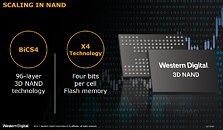Wednesday, June 27th 2018
TrendForce: Price Decline Will Continue in NAND Flash Market in 2H18
The growth momentum for 2H18 NAND Flash market is expected to be weak, according to the latest report of DRAMeXchange, a division of TrendForce. Coupled with continuous improvements in yield rate and output of 64/72-layer 3D NAND Flash, DRAMeXchange expects the market to approach a balance between supply and demand, the contract prices of NAND Flash products are expected to decline further.
The contract prices of NAND Flash products have been decreasing for two consecutive quarters in 1H18 due to the traditional off-season and capacity expansion of 64/72-layer 3D NAND Flash. During this period, suppliers provided competitive prices for high-density products to boost the memory content per box, aiming to further improve the demand in peak season. Meanwhile, suppliers have postponed further plans of capacity expansion, hoping to moderate the price decline.On the demand front, growth momentum for 2H18 NAND Flash market is expected to be weak although Q3 is the traditional peak season, with demand from smartphones, notebooks and tablets growing by 0-1%, 0-1%, and 9-10% QoQ respectively. Suppliers may further lower the quotes to boost the demand, which will result in steeper-than-expected price decline.
Prices decline is expected to continue in 4Q18, yet sales of new iPhones may influence the market situation
Going forward to the fourth quarter, suppliers may not release much new capacity, but the yield rate of 64/72-layer products is expected to grow mature, exceeding 80%. Moreover, suppliers may also add new capacity or transfer some of the current capacity to 96-layer production, which would further boost the bit output growth.In terms of the demand, the momentum remains weak due to slow growth of notebook market, lack of specification upgrade in the smartphone market, and less replacement demand. The demand growth fails to offset the new supply, probably leading to the steeper drop in prices in Q4 compared with Q3. However, the market situation will depend on the sales of new iPhones, which may moderate the price decline.
Osaka earthquake had limited influence on Toshiba and its NAND Flash supply
A 6.1-magnitude earthquake hit Osaka on June 18, 2018. Yokkaichi, where Toshiba's NAND Flash fab locates, also had 4-magnitude tremor. DRAMeXchange learns that Toshiba underwent an inspection immediately after the earthquake, and finished checking the wafers on June 19. Only limited number of wafers were influenced and can be fabricated normally after rework, bringing almost no influence to the market. The fab has returned to full operation soon after that.
Source:
DRAMeXchange
The contract prices of NAND Flash products have been decreasing for two consecutive quarters in 1H18 due to the traditional off-season and capacity expansion of 64/72-layer 3D NAND Flash. During this period, suppliers provided competitive prices for high-density products to boost the memory content per box, aiming to further improve the demand in peak season. Meanwhile, suppliers have postponed further plans of capacity expansion, hoping to moderate the price decline.On the demand front, growth momentum for 2H18 NAND Flash market is expected to be weak although Q3 is the traditional peak season, with demand from smartphones, notebooks and tablets growing by 0-1%, 0-1%, and 9-10% QoQ respectively. Suppliers may further lower the quotes to boost the demand, which will result in steeper-than-expected price decline.
Prices decline is expected to continue in 4Q18, yet sales of new iPhones may influence the market situation
Going forward to the fourth quarter, suppliers may not release much new capacity, but the yield rate of 64/72-layer products is expected to grow mature, exceeding 80%. Moreover, suppliers may also add new capacity or transfer some of the current capacity to 96-layer production, which would further boost the bit output growth.In terms of the demand, the momentum remains weak due to slow growth of notebook market, lack of specification upgrade in the smartphone market, and less replacement demand. The demand growth fails to offset the new supply, probably leading to the steeper drop in prices in Q4 compared with Q3. However, the market situation will depend on the sales of new iPhones, which may moderate the price decline.
Osaka earthquake had limited influence on Toshiba and its NAND Flash supply
A 6.1-magnitude earthquake hit Osaka on June 18, 2018. Yokkaichi, where Toshiba's NAND Flash fab locates, also had 4-magnitude tremor. DRAMeXchange learns that Toshiba underwent an inspection immediately after the earthquake, and finished checking the wafers on June 19. Only limited number of wafers were influenced and can be fabricated normally after rework, bringing almost no influence to the market. The fab has returned to full operation soon after that.


9 Comments on TrendForce: Price Decline Will Continue in NAND Flash Market in 2H18
Price fixing at the highest level.
Starting a syndicate of manufacturers with aim to stiff customers out of billions should be equal to organized crime and punished accordingly.
I hope it's a colossal amount of money, not the pitiful fine they all got last time, as it doesn't work at such a low level. This press release is enough evidence of the brass balls on this lot. They just don't care how illegal what they are doing is, or who knows it.
It's a real good thing that Earthquake hit... They were almost out of excuses. Earthquake is a little more reasonable than the FAB fire or toxic chemical spill I was expecting from them, hell, they probably will still have a fire anyway, just to be sure.
BTW I think people missed the memo here, this is about NAND not DRAM chips... Price/GB has been dropping steadily since the SSD was introduced... the article even clearly points that out on several points. Come on.